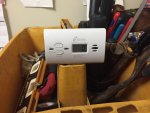I would expect that the button would give you the highest level recorded in the last N hours, not the level the sensor will report 15 minutes from now.
But is the sensor really that slow or is it the cycle time of reading it?
Your premise seems to be spot on. Here is some info pulled off the website.
CarbonCarbon Monoxide PPM Levels
(model KN-COPP-B-LPM with digital display only)
Model KN-COPP-B-LPM is equipped with a digital display that shows
levels of CO (displayed in PPM ? parts per million). Learn the difference
between dangerous, high, mid and low levels.
Dangerous Levels:
When someone is experiencing symptoms of CO poisoning and CO read-
ings are generally above 100 PPM. Anytime someone is experiencing the
symptoms of CO poisoning this should be treated as an emergency. See
?What to do When the Alarm Sounds? (inside front cover).
High Levels:
Generally above 100 PPM, with no one experiencing symptoms. This
should be treated as an urgent situation. See ?What to do When the
Alarm Sounds? (inside front cover).
Mid Levels:
Generally between 50 PPM to 100 PPM. This should be cause for concern
and should not be ignored or dismissed. See ?What to do When the
Alarm Sounds? (inside front cover).
Low Levels:
Generally below 50 PPM. Kidde recommends you take action to eliminate
the source of CO. See ?What to do When the Alarm Sounds? (inside
front cover).
-------------------------------------------------------------------------------------------------
This CO alarm is designed to act as a monitor; it is not designed for use
as a short-term testing device to perform a quick check for the presence
of CO.
------------------------------------------------------------------------------------------------
Accuracy of Digital Display: (Model KN-COPP-B-LPM Only)
30-999 PPM +/-30% when measured in conditions of 80? F (+/- 10?
F), atmospheric pressure +/- 10% and 40% +/- 3% relative humidity.
Display readings may vary slightly depending on changes in the ambient
condition (temperature, humidity) and the condition of the sensor.
Alarm Response Times:
70 PPM = 60-240 min., 150 PPM = 10-50 min., 400 PPM = 4-15 min.



